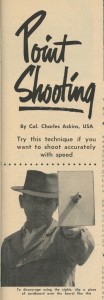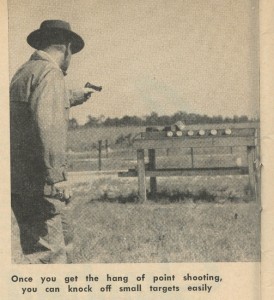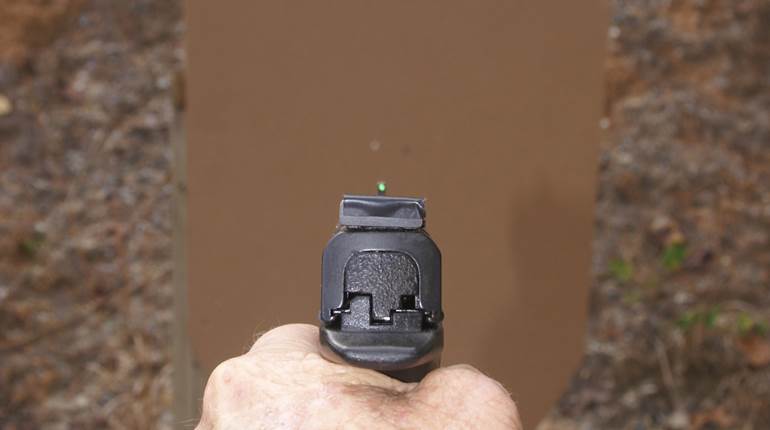
Point Shooting By Col. Charles Askins, USA
I sometimes think we overdid the refinements we have added to the one-hand gun. For instance, the hardware lays 'em in faster when the sights are disregarded. If you are really bent on speed, a one-hand shooting iron has got to be pointed and not aimed. It is that kind of a tool. Sights on a handgun are just like gyro-stabilizers on a wheelbarrow—nice but not necessary. The handgun was designed for defense, and even though that salient fact is oft-times disregarded, it is still true.
For speed, no sights
Sights, when you are actually in a hurry with a six-gun, just complicate an otherwise simple item. Too, these appurtenances confuse the picture, tend to give rise to false hopes, and by inference promise a performance that inherently cannot be. A six-shooter for speed work needs neither a front post nor a notched rear. When you are really in a hurry, the sights add nothing: by the same token they do not get much in the way either. You simply do not see them.
The handgun can be made to hit by pointing. Not by pointing in the sense that you look through the sights but rather by directing the weapon just as you point your finger. Thus manhandled, the six-gun is effective. Of course, you do not hit at 50 yards but you do connect at practical distances. The art of shooting by pointing is so little explored that no one knows just what the ultimate possibilities may be.
What are the possibilities?
What can be done by simply extending the weapon, either at eye level or hip level, and then triggering off a half-dozen quick salvos? Among other things, the slugs can be fitted very neatly inside a head-size target at 20 feet and all in a limit of two or three seconds for the six-shot burst. Or if you like to vary the fun, you can pour three bullets into the head and three into the chest of a silhouette target and the time is extended only some tenths of a second.
The somewhat quaint notion persists that any kind of gun fire not tied to a careful alignment of the sights simply cannot be accurate. Hits are luck, and of a kind that won't repeat itself. This reasoning stems from only a half-knowledge of the capabilities of the one-hand gun.The revolver or automatic never really comes into its own until the piece is fired by pointing, at moderate to short ranges, and in a time-space that rolls the three-, four-, or six-shot burst into one sweet ripple of gun fire.
The six-gun really comes into its own when the trigger is set afire in this manner. True, you cannot hit bullseyes, but why evaluate a good weapon in terms of what it does on a geometric figure?
What makes it so?
The successful control of the gun depends largely on sensing. The gunner slams it into alignment and, like the wingshot, fires the instant the muzzle comes to bear. There is no hesitation, no correction, and no time to pre-quarterback the burst. Target shooters take deliberate aim, but this isn't for the point-shooter, he lines up his muzzle with the target during the first quarter-second and burns powder!
To my way of thinking, the best-pointing of our miscellany of hand-cannon are the guns of High Standard. Almost as good is the Colt Woodsman; a real natural was the old Remington Model 51 automatic, now disappeared from the scene. The old Frontier Model revolver points sweetly from the hip, but just so-so when brought to eye level.
Autos are better
None of the revolvers points as well as the .22 automatics. Basic principle of point-shooting is that the gun is directed as you point your finger. The weapon does not want to be too lengthy for that reason. A barrel of four inches is very close to perfection; barrels of six inches are not nearly so good. The gun wants to have some weight about it, else it will bounce so painfully as to produce bloated groups and many over-the-fence misses.Cut a common playing card and slip it over the front sight and along the barrel. This bit of pasteboard neatly writes finish to the conventional use of the sights. It is now a gun to be pointed and not aimed.
Have a go at it
Try a clip of cartridges at a handy target. Select a mark at practicable range—say an ordinary gallon oil can at 20 feet. Do not shoot once. Trigger off two, three or four shots. Do not look at the gun; watch the target. Move the hardware into the line-of-sight without consciously looking at the gun. Do not permit your attention to wander from the oil can. If the first or second quickly triggered slugs do not plop home, whip the gun in that direction aimed at 'ringing the bell.' This movement, infinitesimal though it is, develops subconsciously and it is amazing how precisely it may be controlled. Do not count scores or any such tommyrot. There will always be shots outside the primary group if you do not finally become so skilled as to pour all your lead into one ragged hole. Bogey of the targetman is his misses. It isn't the tens that loom up so large--it is the occasional wide six. In your new game of point-and-shoot, the hit is the thing!
It requires ammo
Hombres who are limited as to hull supply had better shy around point-shooting. It is a game that might well have been dreamed up by the cartridge makers themselves. It isn't a pastime learned by snapping practice nor yet through the expenditure of a box of cartridges every second week. Powder has got to be burned, and by the keg!
The gunner has finally got to reach that point where he subconsciously points at the target—just like reaching your mouth with a succulent forkful, in the dark. You must finally point the gun as you do your finger. While it may sound as though nothing could be more simple, it requires a good many thousands of shots to get to that rewarding degree of proficiency.
The grip on the gun should be extremely hard. This grasp is maintained for only a few seconds. The arm should be rigid from shoulder to wrist. As to whether it is straightened or bent, the shooting interval is so brief it does not matter. The application of plenty of 'English' dampens recoil, holds the piece dead on, and is essential to successful gunning. Do not roll the weapon into a vertical position such as target marksmen do. That is an unnatural and uncomfortable position for the hand. Give the shooting iron a decided list it will handle more easily.
Stance is immaterial
Your shooting stance or body position is of no importance. It is better, possibly, to stand on both feet but really not too necessary. You will find, after practice, that you are firing while falling, wheeling, squatting, leaping, or essaying other gymnastics. It is contributory to better accuracy if you see the target with both eyes open, though not absolutely necessary, however. This shooting style bears little relation to the well-known and accepted firings, and for that reason has a rule book all its own. The time-space to get off a burst of three, four, or six shots is so short that neither stance, breathing, nor the other bugaboos of the targeteer have too much application.
What can be done by point-shooting? Six shots can be kept on a playing card at 20 feet and all in the space of two to three seconds. I repeatedly kill bullfrogs, snakes, and turtles along a nearby creek and take them, all at distances up to 20-25 feet with this new, dynamic-shooting style. A recent morning I jumped two rabbits—cottontails—at my feet, and killed both of them before they had gone ten long steps.
From the hip, in intervals of two-three seconds, the Army silhouette can be plastered at distances up to 25 feet with all six shots and the group can be covered with your hand.
A further angle is to line six silhouettes in a row and, commencing on the left, run the row with a slug for each. Time, not more than three seconds and probably less.
No one knows the ultimate possibilities of this fascinating shooting-by-pointing game. It is a golden road a-beckoning.








































